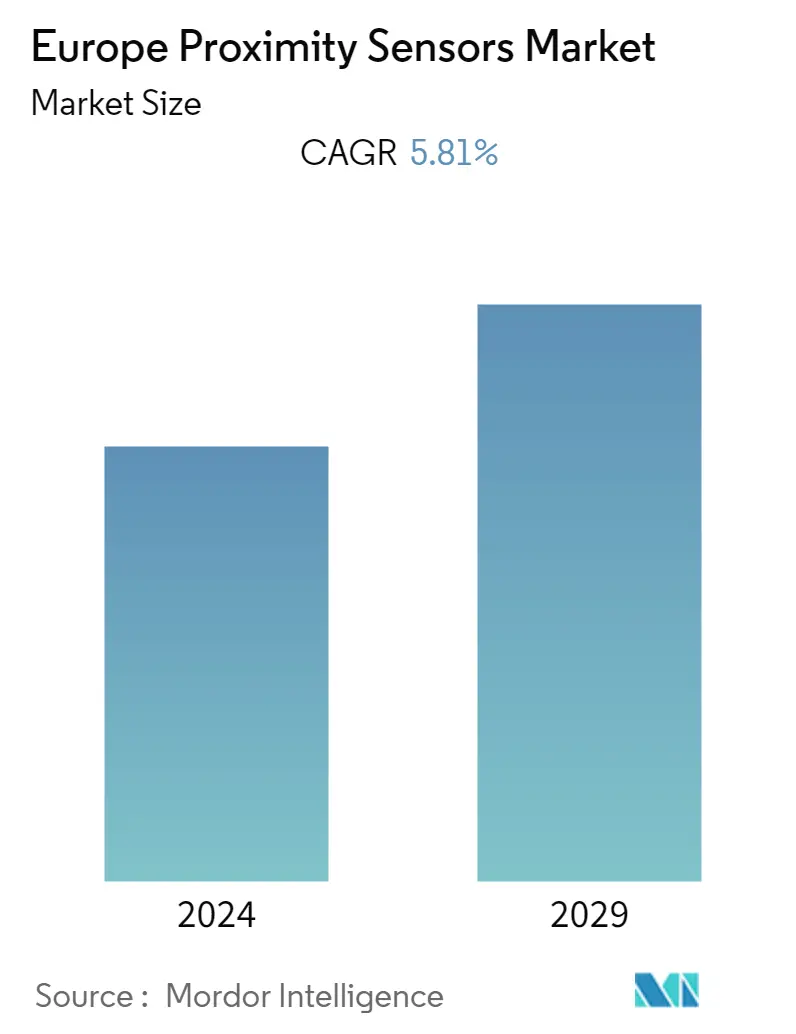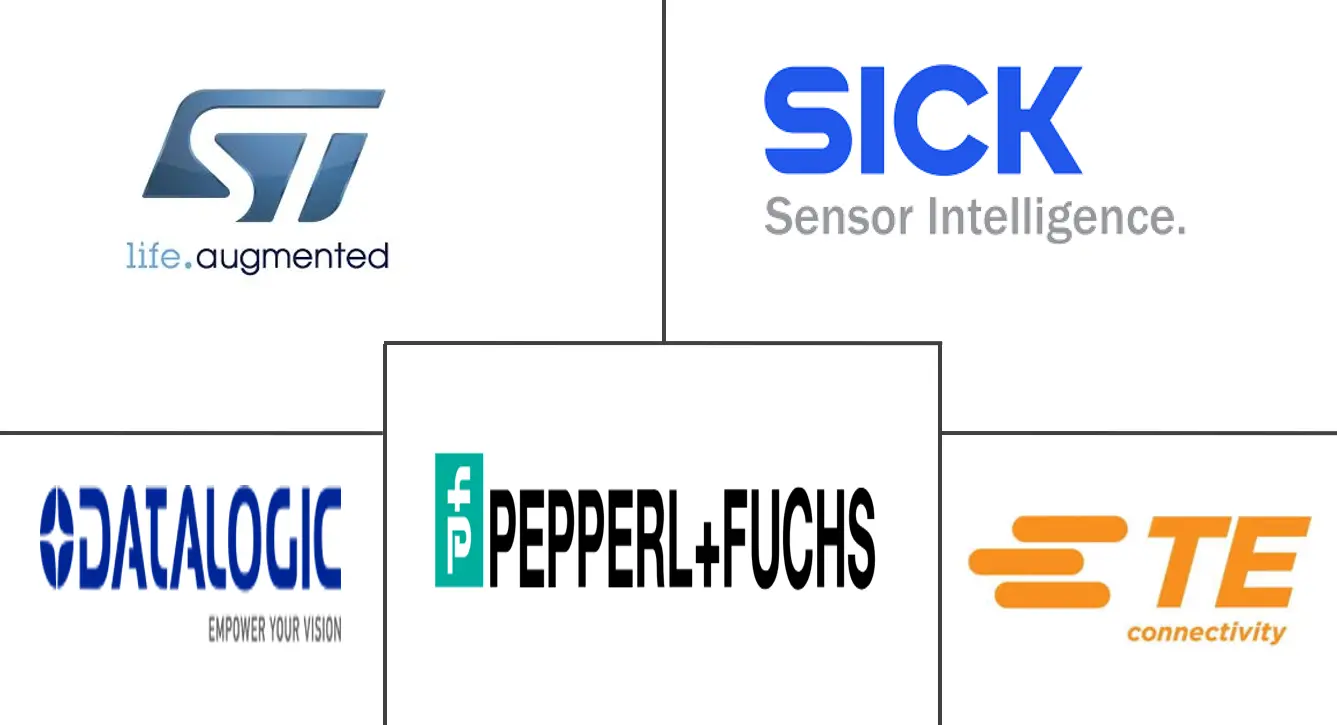Market Size of Europe Proximity Sensors Industry

| Study Period | 2019 - 2029 |
| Base Year For Estimation | 2023 |
| Forecast Data Period | 2024 - 2029 |
| Historical Data Period | 2019 - 2022 |
| CAGR | 5.81 % |
| Market Concentration | Medium |
Major Players
*Disclaimer: Major Players sorted in no particular order |
Europe Proximity Sensors Market Analysis
The Europe proximity sensor market is expected to grow at a CAGR of 5.81% during the forecast period. The rise in the automation of complex production systems led to an increase in the demand for components, which are proficient in providing important data regarding the production process thus boosting the proximity sensor in Europe.
- The ability of proximity sensors to work in hazardous conditions, such as extreme humidity and temperature, as well as in chemical processing applications, aided the growth of the proximity sensors market. For instance, SICK AG offers Inductive Proximity sensors, which are used in almost every area of factory and logistics automation. From cylindrical and rectangular standard sensors to special sensors for explosive zones and harsh environments, these sensors provide an intelligent, reliable route in implementing industry-specific and customized solutions to any automation scheme.
- The increasing cost of labor, combined with the immense pressure on manufacturers to meet the deadlines, has resulted in an increase of automation in factories across Europe. The rising number of warehouses and increasing investments in warehouse automation, coupled with the rise in labor costs and availability of scalable technological solutions in Europe, have been driving the market for warehouse robots across the European countries and demand for proximity sensors.
- For instance, in September 2019, ThyssenKrupp Materials Services, the distribution and service provider of the ThyssenKrupp Group, revealed its plan the to invest EUR 70 million to modernize the existing a state-of-the-art logistics center and expand by new warehouses in Germany, Poland and Hungary.
- Moreover, adoption of home automation and consumer convenience devices such as smart thermostats, smart light bulbs, smart security cameras, smart air conditioners, smart door locks, smart plugs, smart speakers, etc., are driving the demand for smart sensing technologies which utilize proximity sensors. As homes are becoming dependent on smart technologies, smart appliances with non-contact sensing technologies may be favored to support future smart home infrastructure. For instance, Philips's smart bulbs for indoor and outdoor lighting uses proximity sensor.
Europe Proximity Sensors Industry Segmentation
A proximity sensor is a sensor that is able to detect the presence of nearby objects without any physical contact. For sensing objects, this sensor radiates or emits a beam of electromagnetic radiation, usually in the form of infrared light, and detects the reflection to determine the object's proximity or distance from the sensor. A proximity sensor often emits an electromagnetic field or a beam of electromagnetic radiation (for instance, infrared) and detects changes in the field or return signal.
| Technology | |
| Inductive | |
| Capacitive | |
| Photoelectric | |
| Magnetic |
| End-User | |
| Aerospace and Defense | |
| Automotive | |
| Industrial | |
| Consumer Electronics | |
| Food and Beverage | |
| Other End-user Verticals |
| Country | |
| Germany | |
| United Kingdom | |
| France | |
| Italy | |
| Rest of Europe |
Europe Proximity Sensors Market Size Summary
The Europe proximity sensor market is experiencing significant growth, driven by the increasing automation of complex production systems and the demand for reliable data on production processes. Proximity sensors are gaining traction due to their ability to operate in hazardous conditions, such as extreme temperatures and chemical environments, making them essential in factory and logistics automation. The rise in labor costs and the need for efficient manufacturing processes are pushing European manufacturers towards automation, further boosting the demand for proximity sensors. Additionally, the growing adoption of smart home technologies and consumer convenience devices is fueling the need for smart sensing technologies that utilize proximity sensors, as homes increasingly rely on smart technologies for enhanced convenience and security.
The automotive and consumer electronics sectors are also contributing to the market's expansion, with proximity sensors playing a crucial role in autonomous driving and vehicle safety systems. The push towards electric and hybrid vehicles, supported by government initiatives across Europe, is expected to further drive the demand for proximity sensors in the automotive industry. In the aerospace and defense sector, proximity sensors are vital for safety-critical applications, with investments in research and development driving innovation and adoption. The market is dominated by major players like Sick AG, STMicroelectronics NV, and TE Connectivity Ltd., who are expanding their presence through strategic collaborations and acquisitions. These companies are leveraging technological advancements to enhance their product offerings and maintain a competitive edge in the market.
Europe Proximity Sensors Market Size - Table of Contents
-
1. MARKET DYNAMICS
-
1.1 Market Overview
-
1.2 Industry Value Chain Analysis
-
1.3 Industry Attractiveness - Porter's Five Forces Analysis
-
1.3.1 Bargaining Power of Suppliers
-
1.3.2 Bargaining Power of Buyers
-
1.3.3 Threat of New Entrants
-
1.3.4 Intensity of Competitive Rivalry
-
1.3.5 Threat of Substitute Products
-
-
1.4 Impact of COVID-19 on the Market
-
1.5 Market Drivers
-
1.5.1 Growth in Industrial Automation
-
-
1.6 Market Restraints
-
1.6.1 Limitations in Sensing Capabilities
-
-
-
2. MARKET SEGMENTATION
-
2.1 Technology
-
2.1.1 Inductive
-
2.1.2 Capacitive
-
2.1.3 Photoelectric
-
2.1.4 Magnetic
-
-
2.2 End-User
-
2.2.1 Aerospace and Defense
-
2.2.2 Automotive
-
2.2.3 Industrial
-
2.2.4 Consumer Electronics
-
2.2.5 Food and Beverage
-
2.2.6 Other End-user Verticals
-
-
2.3 Country
-
2.3.1 Germany
-
2.3.2 United Kingdom
-
2.3.3 France
-
2.3.4 Italy
-
2.3.5 Rest of Europe
-
-
Europe Proximity Sensors Market Size FAQs
What is the current Europe Proximity Sensors Market size?
The Europe Proximity Sensors Market is projected to register a CAGR of 5.81% during the forecast period (2024-2029)
Who are the key players in Europe Proximity Sensors Market?
Sick AG, STMicroelectronics NV, Datalogic SpA, Pepperl+Fuchs GmbH and TE Connectivity Ltd. are the major companies operating in the Europe Proximity Sensors Market.

